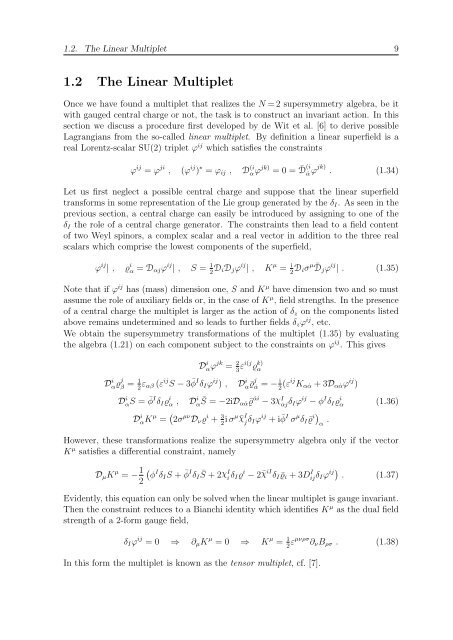N=2 Supersymmetric Gauge Theories with Nonpolynomial Interactions
N=2 Supersymmetric Gauge Theories with Nonpolynomial Interactions
N=2 Supersymmetric Gauge Theories with Nonpolynomial Interactions
Create successful ePaper yourself
Turn your PDF publications into a flip-book with our unique Google optimized e-Paper software.
1.2. The Linear Multiplet 9<br />
1.2 The Linear Multiplet<br />
Once we have found a multiplet that realizes the N = 2 supersymmetry algebra, be it<br />
<strong>with</strong> gauged central charge or not, the task is to construct an invariant action. In this<br />
section we discuss a procedure first developed by de Wit et al. [6] to derive possible<br />
Lagrangians from the so-called linear multiplet. By definition a linear superfield is a<br />
real Lorentz-scalar SU(2) triplet ϕ ij which satisfies the constraints<br />
ϕ ij = ϕ ji , (ϕ ij ) ∗ = ϕij , D (i<br />
αϕ jk) = 0 = ¯ D (i<br />
˙α ϕjk) . (1.34)<br />
Let us first neglect a possible central charge and suppose that the linear superfield<br />
transforms in some representation of the Lie group generated by the δI. As seen in the<br />
previous section, a central charge can easily be introduced by assigning to one of the<br />
δI the role of a central charge generator. The constraints then lead to a field content<br />
of two Weyl spinors, a complex scalar and a real vector in addition to the three real<br />
scalars which comprise the lowest components of the superfield,<br />
ϕ ij | , ϱ i α = Dαjϕ ij | , S = 1<br />
2 DiDjϕ ij | , K µ = i<br />
2 Diσ µ ¯ Djϕ ij | . (1.35)<br />
Note that if ϕ ij has (mass) dimension one, S and K µ have dimension two and so must<br />
assume the role of auxiliary fields or, in the case of K µ , field strengths. In the presence<br />
of a central charge the multiplet is larger as the action of δz on the components listed<br />
above remains undetermined and so leads to further fields δzϕ ij , etc.<br />
We obtain the supersymmetry transformations of the multiplet (1.35) by evaluating<br />
the algebra (1.21) on each component subject to the constraints on ϕ ij . This gives<br />
D i αϕ jk = 2<br />
3εi(j ϱ k)<br />
α<br />
D i αϱ j 1<br />
β = 2εαβ (ε ij S − 3 ¯ φ I δIϕ ij ) , D i α ¯ϱ j i<br />
˙α = − 2 (εijKα ˙α + 3Dα ˙αϕ ij )<br />
D i αS = ¯ φ I δIϱ i α , D i α ¯ S = −2iDα ˙α ¯ϱ ˙αi − 3χ I αjδIϕ ij − φ I δIϱ i α (1.36)<br />
D i αK µ = 2σ µν Dνϱ i + 3<br />
2 i σµ ¯χ I<br />
jδIϕ ij + i ¯ φ I σ µ δI ¯ϱ i<br />
α .<br />
However, these transformations realize the supersymmetry algebra only if the vector<br />
K µ satisfies a differential constraint, namely<br />
DµK µ = − 1 I<br />
φ δIS +<br />
2<br />
¯ φ I δI ¯ S + 2χI i δIϱ i − 2¯χ iI δI ¯ϱi + 3D I ijδIϕ ij . (1.37)<br />
Evidently, this equation can only be solved when the linear multiplet is gauge invariant.<br />
Then the constraint reduces to a Bianchi identity which identifies K µ as the dual field<br />
strength of a 2-form gauge field,<br />
δIϕ ij = 0 ⇒ ∂µK µ = 0 ⇒ K µ = 1<br />
2 εµνρσ ∂νBρσ . (1.38)<br />
In this form the multiplet is known as the tensor multiplet, cf. [7].

















